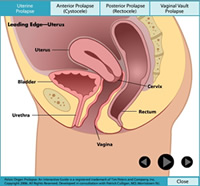 The uterus is held in position by pelvic muscles, ligaments and other tissues. If the uterus drops out of its normal position, this is called prolapse. Prolapse is defined as a body part falling or slipping out of position. Prolapse happens when the pelvic muscles and connective tissues weaken. The uterus can slip to the extent that it drops partially into the vagina and creates a noticeable lump or bulge. This is called incomplete prolapse. Complete prolapse occurs when the uterus slips to such a degree that some uterine tissue is outside the vagina.
The uterus is held in position by pelvic muscles, ligaments and other tissues. If the uterus drops out of its normal position, this is called prolapse. Prolapse is defined as a body part falling or slipping out of position. Prolapse happens when the pelvic muscles and connective tissues weaken. The uterus can slip to the extent that it drops partially into the vagina and creates a noticeable lump or bulge. This is called incomplete prolapse. Complete prolapse occurs when the uterus slips to such a degree that some uterine tissue is outside the vagina.
Pelvic prolapse is usually accompanied by some degree of vaginal vault prolapse. Vaginal vault prolapse occurs when the upper part of the vagina loses its shape and sags into the vaginal canal or outside the vagina. Pelvic prolapse may also involve sagging or slipping of other pelvic organs, including the bladder, the urethra which is the tube next to the vagina that allows urine to leave your body, and rectum
Anatomy of the Vagina
The vaginal vault is the “ceiling” or the inner, upper end of the vagina. The vaginal vault has four “compartments”: an anterior compartment, closest to the front of the body; the vaginal wall; a middle compartment consisting of the cervix; and a posterior compartment consisting of the vaginal wall at the back of the body.
Signs & Symptoms
Women with mild cases of pelvic prolapse may have no noticeable symptoms. However, as the uterus falls further out of position, it can place pressure on other pelvic organs—such as the bladder or bowel — causing a variety of symptoms, including:
- Sensation of sitting on a small ball
- Heaviness or pulling in the pelvis
- Pelvic or abdominal pain
- Pain during intercourse
- Protrusion of tissue from the opening of the vagina
- Repeated bladder infections
- Vaginal bleeding or an unusual or excessive discharge
- Constipation
- Frequent urination or an urgent need to empty your bladder
Symptoms may worsen with prolonged standing or walking due to added pressure placed on the pelvic muscles by gravity.
Causes and Risk Factors
Pelvic prolapse is fairly common and the risk of developing the condition increases with age. It can occur in women who have had one or more vaginal births. Normal aging and lack of estrogen after menopause may also cause pelvic prolapse. Chronic coughing, heavy lifting and obesity increase the pressure on the pelvic floor and may contribute to the condition. Although rare, pelvic prolapse can also be caused by a pelvic tumor. Chronic constipation and the pushing associated with it can worsen pelvic prolapse.
Screening & Diagnosis
Diagnosing pelvic prolapse requires a pelvic examination usually performed by a gynecologist. The doctor will ask about your medical history and perform a complete pelvic examination to check for signs of pelvic prolapse. You may be examined while lying down and standing. Imaging tests, such as ultrasound or magnetic resonance imaging (MRI), may be performed to further evaluate the pelvic prolapse.
